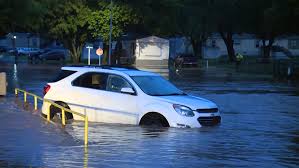
Dangers of Driving in Water - Engine Hydrolocking
Share
Many drivers underestimate the risks of driving through deep water, especially during heavy rain, floods, or after storms. While water may seem like a minor obstacle, it can cause significant damage to your vehicle, particularly to the engine. One of the most severe consequences of driving through standing or flowing water is hydrolocking—a potentially catastrophic engine failure.
Generally, if the water level reaches or exceeds the height of the air intake or the bottom of the rocker panels, your can become hydrolocked.
What Is Hydrolocking?
Hydrolocking (short for hydrostatic lock) occurs when water enters the engine’s combustion chamber, replacing the air that is supposed to be compressed during normal operation. Unlike air, water is incompressible, which can lead to the engine seizing up and causing extensive damage.
How to Tell If Your Engine Is Hydrolocked
If you suspect your engine may be hydrolocked, here are some key warning signs to look for:
Sudden Engine Stall: If your engine stops abruptly while driving through water, it may have ingested water.
Starter Motor Issues: When you try to start the vehicle, the engine may not turn over, or the starter may struggle.
Loud Knocking Sounds: If the engine does start, you may hear loud banging or knocking noises, indicating internal damage.
White Smoke or Steam from the Exhaust: Water contamination can cause excessive steam or smoke when attempting to start the engine.
Visible Water in the Air Intake or Oil: Checking the air filter, intake, or dipstick for water or foamy oil can confirm water intrusion.
How Does Hydrolocking Destroy Your Engine?
When water enters the engine through the air intake, it can prevent the pistons from completing their normal cycle. As the piston tries to compress the water instead of air, the pressure can cause bending or breaking of connecting rods, valves, or other engine components. This can result in a costly repair or even the need for a full engine replacement.
Preventing Hydrolocking
To avoid the risks of hydrolocking, it is crucial to never attempt to drive through deep water unless you are certain of the depth and safety. If you encounter a flooded road, it is best to turn around and find an alternate route. Additionally, maintaining your vehicle's air intake system and ensuring it is properly sealed can help reduce the likelihood of water entering the engine.
What to Do If Your Engine Hydrolocks
If you suspect that your engine has hydrolocked, do not attempt to start the vehicle. Starting the engine can cause further damage. Instead, have the vehicle towed to a trusted mechanic who can assess the extent of the damage and recommend the necessary repairs.
Remember, driving through water may seem harmless, but the consequences can be severe. By understanding the risks of hydrolocking and taking precautions to avoid it, you can protect your vehicle from costly engine damage.

